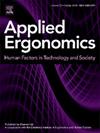用于评估头部侧面压力阈值的自动方法
IF 3.4
2区 工程技术
Q2 ENGINEERING, INDUSTRIAL
引用次数: 0
摘要
这项研究的目的是通过检查头部侧面精确地标的压力敏感性,设计出缓解与眼镜型可穿戴设备相关的压力不适的策略。共有197名健康参与者参与了一项实验,其中使用自动力测量系统施加压力。触觉阈值(TT)、压力不适阈值(PDT)、最大压力耐受性(MPT)和疼痛压力阈值(PPT)在每个参与者头部侧面的16个位置进行测量。使用一系列网格型模板有助于根据个人头部形状和大小定位地标。值得注意的是,耳朵后面的区域表现出更高的压力阈值,而太阳穴水平的区域对压力更敏感。在特定部位观察到性别差异,而年龄(45岁)和BMI与压力阈值没有任何显著相关性。本研究介绍了一种通过头部侧面高密度地标地图来评估压力敏感性的自动化方法。研究结果对头戴式产品的人体工程学设计具有重要意义,特别是对眼镜型可穿戴设备。本文章由计算机程序翻译,如有差异,请以英文原文为准。
An automated approach for assessing pressure thresholds on the side of the head
The aim of this study is to devise strategies for alleviating pressure discomfort associated with glasses-type wearables by examining pressure sensitivity at precise landmarks on the side of the head. A total of 197 healthy participants engaged in an experiment where pressure was applied using an automated force measuring system. Tactile threshold (TT), pressure discomfort threshold (PDT), maximum pressure tolerance (MPT), and pain pressure threshold (PPT) were gauged at 16 locations on the side of the head for each participant. The use of a series of grid-type templates facilitated the localization of landmarks based on individual head shapes and sizes. Notably, the area behind the ears exhibited higher pressure thresholds, while regions where temples sit horizontally were more sensitive to pressure. Gender differences were observed at specific locations, whereas age (<45 years old) and BMI did not exhibit any significant correlation with pressure thresholds. This research introduces an automated methodology for assessing pressure sensitivity through a high-density landmark map on the side of the head. The outcomes have significant implications for the ergonomic design of head-worn products, particularly for glasses-type wearables.
求助全文
通过发布文献求助,成功后即可免费获取论文全文。
去求助
来源期刊

Applied Ergonomics
工程技术-工程:工业
CiteScore
7.50
自引率
9.40%
发文量
248
审稿时长
53 days
期刊介绍:
Applied Ergonomics is aimed at ergonomists and all those interested in applying ergonomics/human factors in the design, planning and management of technical and social systems at work or leisure. Readership is truly international with subscribers in over 50 countries. Professionals for whom Applied Ergonomics is of interest include: ergonomists, designers, industrial engineers, health and safety specialists, systems engineers, design engineers, organizational psychologists, occupational health specialists and human-computer interaction specialists.
 求助内容:
求助内容: 应助结果提醒方式:
应助结果提醒方式:


